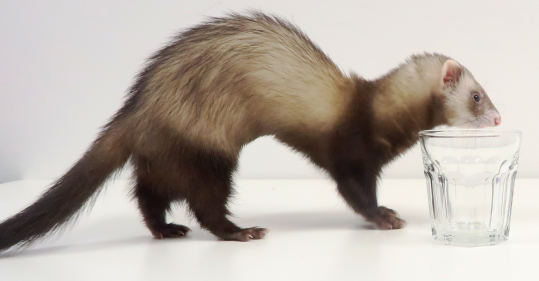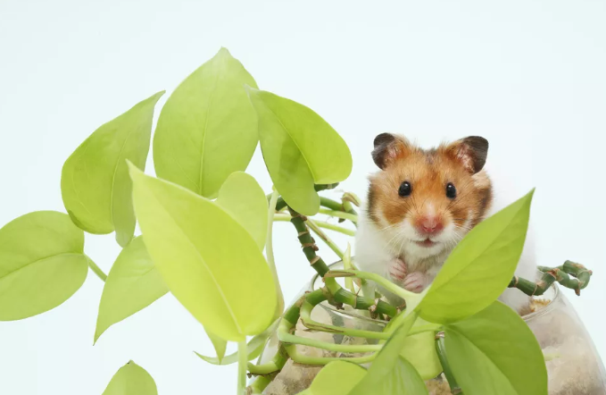Brief Information about a Ferret

- A hob (a male ferret), a jill (a female ferret), and a kit (a baby ferret) (“Friendly Ferret”);
- Animalia (kingdom), Chordata (phylum), Mammalia (class), Carnivora (order), Mustelid (family), Mustela (genus), and Mustela putorius furo (species) (Duda);
- A young lady walked the ferret on Skinner Green. She found a piece (bark) of a dry tree, and the ferret was involved in studying the object;
- Parents presented the ferret to the girl to be someone nearby in a new place;
- It is legal for Massachusetts’ citizens to have a ferret as a pet;
- Ferrets do not play a significant ecosystem role in society. In a larger ecosystem, ferrets become food for predators like hawks and owls.
Brief Information about a Hamster

- Syrian or golden hamster, teddy bear, or fancy (McLeod);
- Animalia (kingdom), Chordata (phylum), Mammalia (class), Rodentia (order), Cricetidae (family), Mesocricetus (genus), and Mesocricetus auratus (species) (Champagne);
- A golden hamster was found with its owner on Skinner Green. In its blue plastic ball, it tried to get around the wall of clothes;
- The girl bought the hamster two years ago and brought it to the campus;
- It is legal for Massachusetts’ citizens to have a hamster as a pet;
- In the existing ecosystem, hamsters are used as a food source for other animals.
Ethical Relationships to Ferrets
Walking on campus, it is easy to find students with a pet in their hands. Holland defined an animal as a multicellular organism and a “natural group (or clade) descended from a shared common ancestor” (4). However, to develop fair human-animal relationships, it is not enough to learn the terms and give definitions. It is important to understand the essence of ethical relationships and consider the full identity of animals and human beings. In this paper, a naturalistic discovery of a ferret’s life on the Mount Holyoke campus will be developed to shape various beliefs and practices in ethical relationships between a human and the chosen pet.
The Mount Holyoke community is known for its clear and supportive attitudes towards animals and their roles in human society and a large ecosystem. The domestication of ferrets is a relatively new practice in the United States. However, in Europe, the first domestic ferrets were used for hunting about 2500 years ago (Duda). People like to share their knowledge about ferrets over the years. Such characteristics of ferrets as a complete digestive system, bilateral symmetry, red blood, and smell make them similar to humans and their basic needs like hunger, thirst, and sleep (Duda). The awareness of the taxonomic classification features provides owners with an opportunity to understand animal preferred habitats and the most appropriate conditions for living.
However, ethical relationships between humans and animals are not as equal as they might be. Ferrets may produce some sounds when there are happy or scared. However, the fact that they have a voice does not mean they can express it compared to humans who clearly identify what is beneficial or harmful to them (Calarco 8). People find it normal to use the physical conditions and body structures of ferrets to perform different tricks with specific training.
All this proves Aristotle’s approach that, as well as plants exist for the sake of animals, animals are for the sake of humans (Calarco 8). There are many institutional histories and knowledge that could shape ethical beliefs. Darwin believed that it was human arrogance that placed them higher than animals (Calarco 11). Singer underlined the worth of equal consideration of interests among sentient animals, both human and nonhuman (Calarco 15). Despite positive emotions and beliefs that they prolong ferrets’ life (ferrets cannot survive in the wild, but as pets, they can live about ten years), people are not able to differentiate their interests from those of their pets.
After evaluating the conditions and biological characteristics of ferrets, I believe that many philosophers would expect to change our ethical relationships with this animal. To be ethically correct, a person should not engage ferrets or even train them because it is impossible to recognize this pet’s true interests. At the same time, ferrets do not live long in the wild, and their domestication is their chance to live longer. The question of ethical justice remains open, but my attitude towards ferrets is to protect them against the threats of the outside world.
Ethical Relationships to Hamsters
The history of animals on Mount Holyoke Campus is various and rich. The choice of pets usually depends on students’ interests, abilities, and intentions. Some people want to have an animal friend not to be lonely. Many persons believe that they can save animals from their participation in research programs. For some students, a pet is not only a friend by a source of inspiration and support. In this essay, attention will be paid to the ethical considerations of the domestication of hamsters and the relationships people develop with this animal.
Ethical relationships between humans and hamsters in the Mount Holyoke community are complex compared to those of ferrets, cats, or other pets. On the one hand, as the representatives of the Cricetidae family, hamsters serve as successful genetic models for human diseases (Allaby 141). It is in the interest of people to protect themselves against health problems and find out new cures and treatment options.
On the other hand, Calarco highlighted a number of questions concerning practices of killing and testing animals for medical reasons (15). Even the most proficient researchers like Singer were not ready to give an absolute answer to this question (Calarco 15). However, an evident conclusion may be formulated that when hamsters are used for experimenting, their preferences and interests are sacrificed in favor of human ones.
At the same time, the conditions under which hamsters are used as beloved pets are characterized by a variety of benefits. Regarding the results of multiple practices and observations, this animal can live for approximately two years in the wild environment and about four years as domesticated animals. Choosing common diets of grains and seeds, a hamster can be easily eaten by another predator as a part of a large ecosystem. Many people believe that human/animal distinction cannot be ignored, and Calarco defined three relevant ethical characteristics proving the full identity of humans and animals, including sentience, subjectivity, and intentionality (20).
As well as people, hamsters develop advanced abilities to feel and expect things. In the majority of cases, owners prefer to keep these animals in special cages with enough equipment being added like a bedding area, a food/water bowl, a toilet, and an exercise wheel. As soon as it is given some food, a hamster would like to hide it, stuffing as much food as possible in its cheeks. Similar behaviors are observed in humans when they try to buy as much as possible if they have an opportunity.
Conclusion
In general, the complexity of ethical relationships between hamsters and humans provokes a number of new questions and debates. Relying on emotions or pity as the major argumentation to domesticate hamsters is not enough. The discussion developed by Calarco made me rethink my ethical relationship with this animal because it is not enough to wish to have a hamster for entertainment or positive emotions. The domestication of hamsters is a huge responsibility that requires knowledge, skills, and patience, and not many people are ready for such a task.
Works Cited
Allaby, Michael, editor. A Dictionary of Zoology. 3rd ed., Oxford University Press, 2009.
Calarco, Matthew. Thinking Through Animals: Identity, Difference, Indistinction. Stanford University Press, 2015.
Champagne, Alex. “Mesocricetus Auratus Golden Hamster.” Animal Diversity Web. Web.
Duda, Jessica. “Mustela Putorius Furo Domestic Ferret.” Animal Diversity Web. Web.
“Friendly Ferret.” ARK. 2019. Web.
Holland, Peter. The Animal Kingdom: A Very Short Introduction. Oxford University Press, 2011.
McLeod, Lianne. “Syrian Hamsters as Pets.” The SprucePets. 2019. Web.